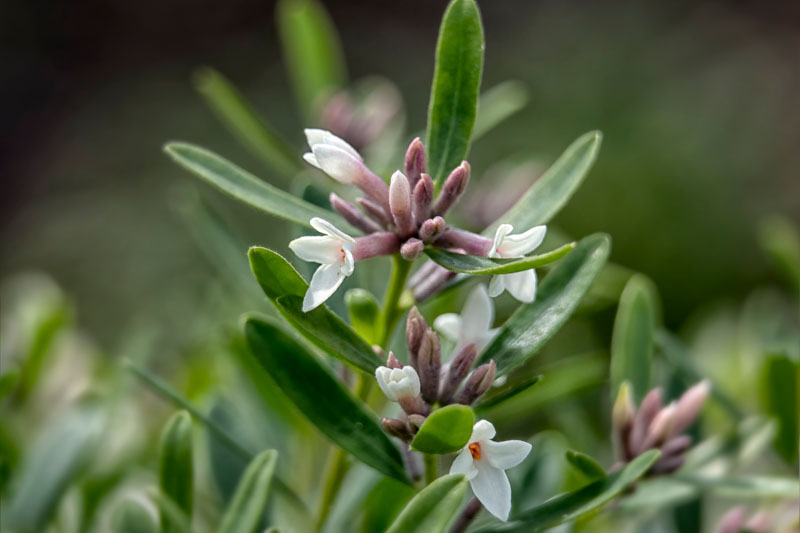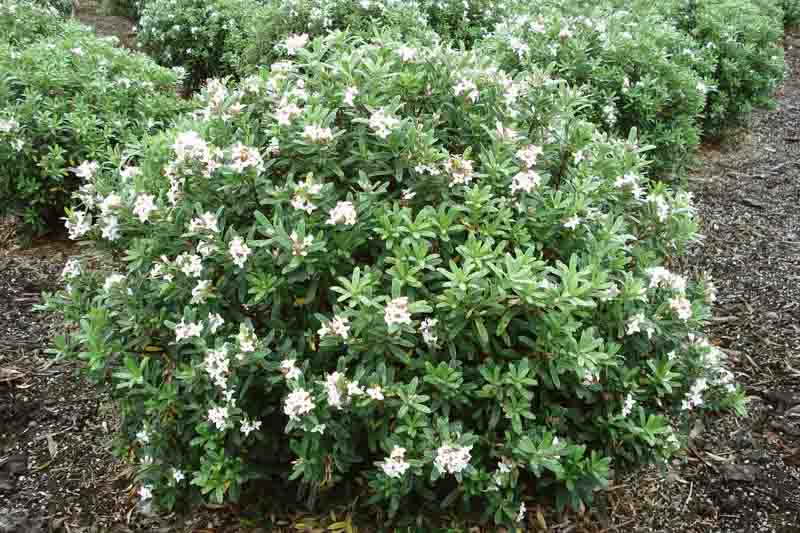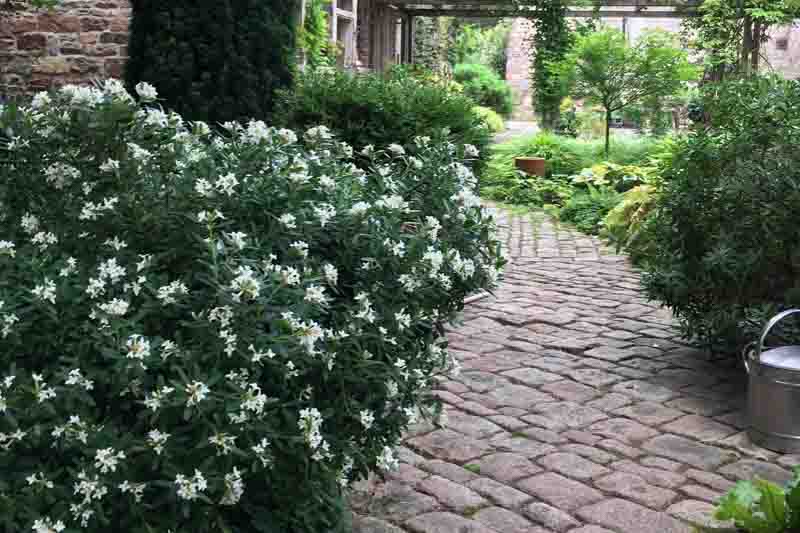Daphne × transatlantica 'Blafra', Daphne × collina 'Eternal Fragrance', Daphne 'Eternal Fragrance'
Daphne × transatlantica Eternal Fragrance is a standout semi-evergreen shrub for those looking to add continuous color and fragrance to their garden. Its hardiness, combined with the extended blooming season and compact size, make it an invaluable addition to a variety of garden styles and settings.
Daphne Eternal Fragrance is renowned for its profusion of sweetly scented, blush pink to white flowers that grace the plant from spring through fall. Its compact growth habit and glossy, green foliage make it an attractive addition to any garden setting.
Native: This plant is a hybrid and does not have a specific native range. It was bred to bring the best qualities of its parent species into a garden-friendly plant. Daphne belongs to the daphne family, Thymelaeaceae.
Plant Type and Habit: It is an evergreen shrub in warmer climates and deciduous in cooler ones, with a rounded, bushy habit that makes it ideal for borders, containers, and as a focal point in small gardens.
Size: Typically, it grows to about 2 to 3 feet tall and wide (60-90 cm), making it a perfect choice for spaces where a compact yet showy plant is desired.
Flowers: The flowers are small but abundant, with a powerful, sweet fragrance that can fill the air around the plant. They bloom in flushes from spring through autumn. Unlike many Daphne shrubs, Eternal Fragrance has an extended blooming period from April to October, providing long-lasting color and scent.

Fruits: It rarely produces fruit, focusing its energy on flower production instead.
Foliage: The foliage is dark green, glossy, and leathery, providing a beautiful backdrop to its flowers and year-round interest in regions where it remains evergreen.
Hardiness: This Daphne is hardy in USDA zones 5 through 9, showing more resilience to cold than some other varieties.
Award: Recipient of the prestigious Award of Garden Merit of the Royal Horticultural Society.
Uses: It’s used in landscapes as a specimen plant, in mixed borders, or in containers where its fragrance can be enjoyed up close.
Wildlife: Its flowers may be visited by bees and butterflies.
Deer and Rabbits: Its toxic properties generally deter deer and rabbits.
Drought and Salt Tolerance: Once established, ‘Eternal Fragrance’ is quite drought-tolerant, although it performs best with regular watering during extended dry periods.
Toxicity: All parts of Daphne shrubs are toxic if ingested, and its sap can irritate the skin, so handle it with care.
Invasiveness: It is not considered invasive. This plant tends to grow slowly and remains well-contained within its intended space.

Light: Prefers full sun to partial shade. Too much shade can reduce flowering, while too much sun can scorch the leaves in hotter climates.
Soil: Thrives inslightly acid to slightly alkaline, well-drained, humus-rich soil.
Water: Requires regular watering to keep the soil moist but not waterlogged. Drought-tolerant once established, but consistent moisture promotes optimal growth and flowering.
Fertilizer: Apply a balanced, slow-release fertilizer in early spring to support healthy growth and flowering.
Pruning: Minimal pruning is needed. Prune lightly after flowering to maintain shape and remove any damaged or dead branches.
Propagation: Best propagated by semi-hardwood cuttings in summer.

Daphne is a beautiful, fragrant shrub with no serious pest or disease issues. However, like all plants, it can be potentially affected by certain pests, diseases, and common problems.
Aphids: These small, sap-sucking insects can congregate on new growth, weakening the plant. A strong jet of water or insecticidal soap can help manage them.
Mealybugs:
Scale Insects: Scale can attach themselves to the stems and underside of leaves, sucking sap and weakening the plant. Horticultural oils or systemic insecticides can be effective treatments.
Root rot: Overwatering or poorly draining soil can lead to root rot, a serious condition that can kill the plant. Ensure good drainage and avoid overwatering.
Fungal Diseases: Leaf spot and other fungal issues can arise in damp conditions or if the plant is not in a well-ventilated space. Prune affected areas and consider fungicidal sprays if the problem persists.
Yellowing Leaves: Overwatering, poor drainage, or nutrient deficiencies can cause leaves to yellow. Adjust watering practices and ensure the soil is well-draining. A soil test can help identify if supplemental fertilization is needed.
Leaf Drop: Winter Daphne may drop leaves in response to stress, such as sudden temperature changes, drought, or transplant shock. Maintaining consistent care can help minimize stress.
Browning Leaves: Can be caused by too much sun, windburn, or frost damage. Planting in a sheltered location that receives partial shade can help prevent these issues.
| Hardiness |
5 - 9 |
|---|---|
| Heat Zones |
7 - 9 |
| Climate Zones | 2B, 3, 3A, 3B, 4, 5, 6, 7, 8, 9, 14, 15, 16, 17 |
| Plant Type | Shrubs |
| Plant Family | Thymelaeaceae |
| Exposure | Full Sun, Partial Sun |
| Season of Interest |
Spring (Late) Summer (Early, Mid, Late) Fall |
| Height |
2' - 3' (60cm - 90cm) |
| Spread |
2' - 3' (60cm - 90cm) |
| Spacing |
24" - 36" (60cm - 90cm) |
| Maintenance | Low |
| Water Needs | Average |
| Soil Type | Chalk, Clay, Loam, Sand |
| Soil pH | Acid, Neutral, Alkaline |
| Soil Drainage | Moist but Well-Drained, Well-Drained |
| Characteristics | Fragrant, Showy, Semi-Evergreen |
| Tolerance | Deer, Rabbit, Drought |
| Attracts | Bees, Butterflies |
| Garden Uses | Beds And Borders, Patio And Containers, Small Gardens |
| Garden Styles | Informal and Cottage, Gravel and Rock Garden, City and Courtyard |
| Hardiness |
5 - 9 |
|---|---|
| Heat Zones |
7 - 9 |
| Climate Zones | 2B, 3, 3A, 3B, 4, 5, 6, 7, 8, 9, 14, 15, 16, 17 |
| Plant Type | Shrubs |
| Plant Family | Thymelaeaceae |
| Exposure | Full Sun, Partial Sun |
| Season of Interest |
Spring (Late) Summer (Early, Mid, Late) Fall |
| Height |
2' - 3' (60cm - 90cm) |
| Spread |
2' - 3' (60cm - 90cm) |
| Spacing |
24" - 36" (60cm - 90cm) |
| Maintenance | Low |
| Water Needs | Average |
| Soil Type | Chalk, Clay, Loam, Sand |
| Soil pH | Acid, Neutral, Alkaline |
| Soil Drainage | Moist but Well-Drained, Well-Drained |
| Characteristics | Fragrant, Showy, Semi-Evergreen |
| Tolerance | Deer, Rabbit, Drought |
| Attracts | Bees, Butterflies |
| Garden Uses | Beds And Borders, Patio And Containers, Small Gardens |
| Garden Styles | Informal and Cottage, Gravel and Rock Garden, City and Courtyard |
How many Daphne x transatlantica ‘Blafra’ ETERNAL FRAGRANCE do I need for my garden?
| Plant | Quantity | |
|---|---|---|
| Daphne x transatlantica ‘Blafra’ ETERNAL FRAGRANCE | N/A | Buy Plants |
Create a membership account to save your garden designs and to view them on any device.
Becoming a contributing member of Gardenia is easy and can be done in just a few minutes. If you provide us with your name, email address and the payment of a modest $25 annual membership fee, you will become a full member, enabling you to design and save up to 25 of your garden design ideas.
Join now and start creating your dream garden!
Create a membership account to save your garden designs and to view them on any device.
Becoming a contributing member of Gardenia is easy and can be done in just a few minutes. If you provide us with your name, email address and the payment of a modest $25 annual membership fee, you will become a full member, enabling you to design and save up to 25 of your garden design ideas.
Join now and start creating your dream garden!